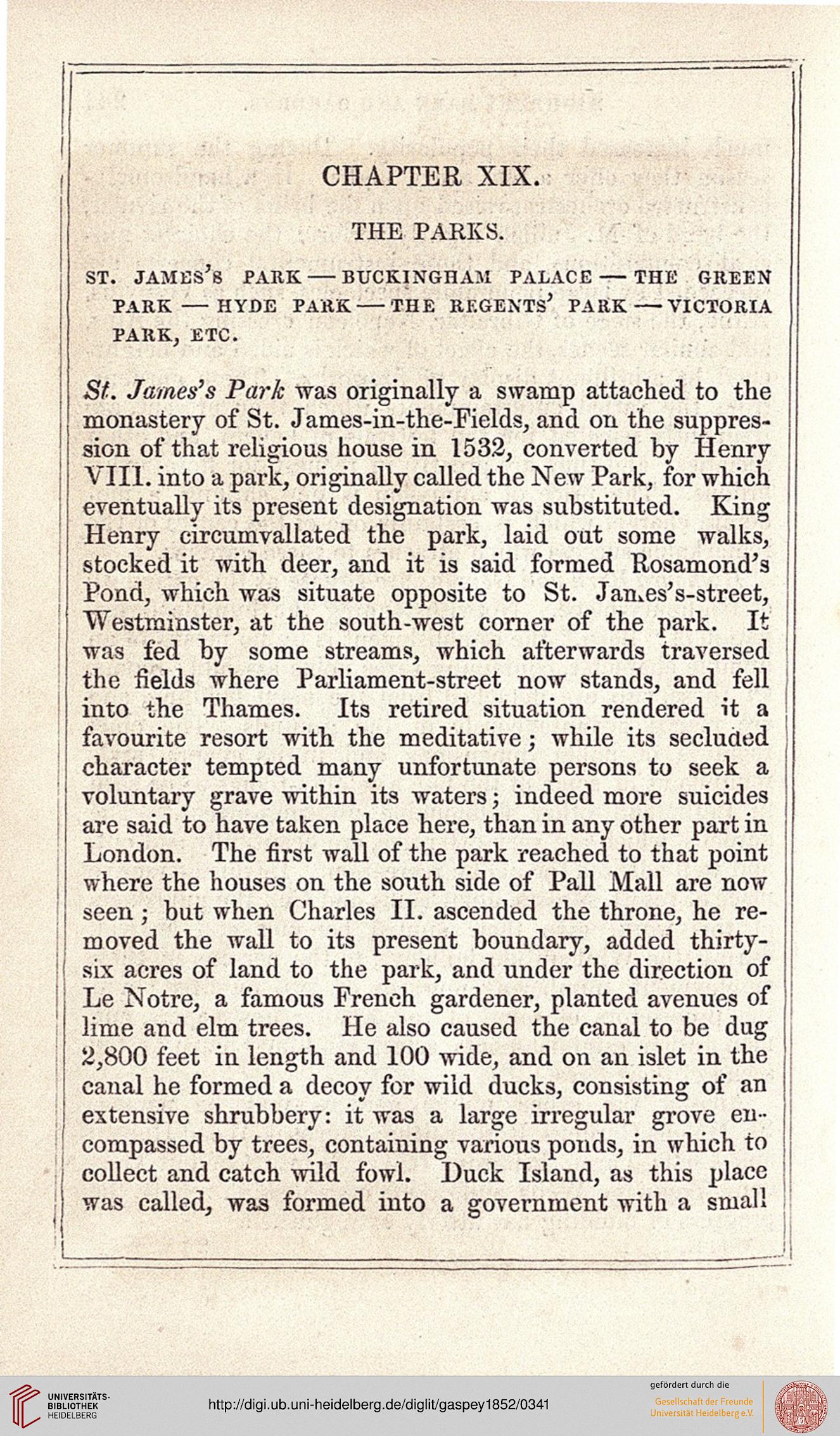CHAPTER XIX.
THE PARKS.
st. james's park — Buckingham palace —the green
park — hyde park---the regents* park—-victoria
PARK, ETC.
St. James's Park was originally a swamp attached to the
monastery of St. James-in-the-Fields, and on the suppres-
sion of that religious house in 1532, converted by Henry
VIII. into a park, originally called the New Park, for which
eventually its present designation was substituted. King
Henry crrcumvallated the park, laid out some walks,
stocked it with deer, and it is said formed Kosamond's
Pond, which was situate opposite to St. James's-street,
Westminster, at the south-west corner of the park. It
was fed by some streams, which afterwards traversed
the fields where Parliament-street now stands, and fell
into the Thames. Its retired situation rendered it a
favourite resort with the meditative; while its secluded
character tempted many unfortunate persons to seek a
voluntary grave within its waters; indeed more suicides
are said to have taken place here, than in any other part in
London. The first wall of the park reached to that point
where the houses on the south side of Pall Mall are now
seen; but when Charles II. ascended the throne, he re-
moved the wall to its present boundary, added thirty-
six acres of land to the park, and under the direction of
Le Notre, a famous French gardener, planted avenues of
lime and elm trees. He also caused the canal to be dug
2,800 feet in length and 100 wide, and on an islet in the
canal he formed a decoy for wild dncks, consisting of an
extensive shrubbery: it was a large irregular grove en-
compassed by trees, containing various ponds, in which to
collect and catch mid fowl. Duck Island, as this place
was called, was formed into a government with a small
THE PARKS.
st. james's park — Buckingham palace —the green
park — hyde park---the regents* park—-victoria
PARK, ETC.
St. James's Park was originally a swamp attached to the
monastery of St. James-in-the-Fields, and on the suppres-
sion of that religious house in 1532, converted by Henry
VIII. into a park, originally called the New Park, for which
eventually its present designation was substituted. King
Henry crrcumvallated the park, laid out some walks,
stocked it with deer, and it is said formed Kosamond's
Pond, which was situate opposite to St. James's-street,
Westminster, at the south-west corner of the park. It
was fed by some streams, which afterwards traversed
the fields where Parliament-street now stands, and fell
into the Thames. Its retired situation rendered it a
favourite resort with the meditative; while its secluded
character tempted many unfortunate persons to seek a
voluntary grave within its waters; indeed more suicides
are said to have taken place here, than in any other part in
London. The first wall of the park reached to that point
where the houses on the south side of Pall Mall are now
seen; but when Charles II. ascended the throne, he re-
moved the wall to its present boundary, added thirty-
six acres of land to the park, and under the direction of
Le Notre, a famous French gardener, planted avenues of
lime and elm trees. He also caused the canal to be dug
2,800 feet in length and 100 wide, and on an islet in the
canal he formed a decoy for wild dncks, consisting of an
extensive shrubbery: it was a large irregular grove en-
compassed by trees, containing various ponds, in which to
collect and catch mid fowl. Duck Island, as this place
was called, was formed into a government with a small




